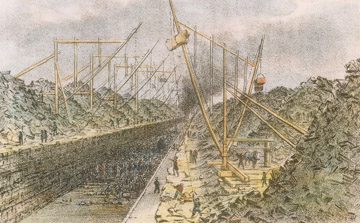|
Those Among Us
Uncovering the Story of Who Built the Erie Canal
by
Terry Toscano Shenfield
Exhibit through Sept. 17, 2006, at the Erie Canal Museum
318 Erie Boulevard East in downtown Syracuse

Engineering ingenuity was put to the test when construction
reached the 70 foot high Niagara Escarpment. Derricks were constructed
every 70 feet to hoist and remove stone debris blasted from the canal
chamber. Powered by one horse, each derrick could lift one ton of
stone in a single bucket load. It took two years to carve this seven
mile stone trench to Buffalo. Illustration from Process of Excavation,
Lockport. Memoir of the Celebration of the Completion of the New York
Canals, by Cadwallader D. Colden, 1825. Collection of the Erie
Canal Museum.
On July 4, 1817, in Rome, work crews equipped with shovels and basic
tools began work on the greatest engineering marvel in American history.
The original "Clinton's Ditch" cost $7.2 million and eight years to construct.
The Erie Canal was so successful that it had paid for itself within seventeen
years and an enlargement was necessary to accommodate the flow of commerce
and the industry that grew and flourished along its banks.
The Erie Canal was truly a "portal to prosperity" for our developing
nation. This is graphically portrayed in a new exhibition at the Erie
Canal Museum in Syracuse.
This great vision was brought to reality by New England's original European
settlers and immigrants who came to America throughout the 1800's. The
Erie offered not only lucrative employment, but the opportunity for immigrants
seeking relief from famine and economic depression in their native land
to start a new life in this new country. With strong backs and great tenacity,
these thousands of individuals dug an artificial waterway across New York
State opening the western frontier to settlement and launching the nation
into an era of canal transportation that would continue for more than
100 years. Like many canal companies of the time, the Erie Canal builders
made quick use of laborers they saw as "men of action" by employing them
as blasters; men who handled explosives with a sense of ease, an air of
confidence, and with a copious amount of pride in their work. A few blasters
even became legendary by their awe-inspiring use of pyrotechnics. For
example, a blaster by the name of Patten earned himself a bonus of $100
by using only one blast to land a boulder on the canal bank that saved
his contractor the expense of building an entire embankment! Other blasters
with equally amazing feats of skill soon brandished monikers such as "Hercules,"
"Bob the Blaster," and "Monster Manley." Adapted from Common
Labor by Peter Way.
Living life in the fast lane for many canal laborers could run some needless
risks. A canal traveler once noted that the Irish laborers were often
so nonchalant about the explosions of gunpowder going off about them that
instead of running to their designated safety shelters, they'd merely
hold their shovels over their heads to keep the small stones from hitting
them. Unfortunately, their shovels provided no protection from the occasional
boulder that would, every now and then, crush one of them. Adapted
from Common Labor by Peter Way.
Crude but effective innovations were born to overcome obstacles to canal
construction. The stump-puller, for example, a peculiar looking but ingenious
device enabled workers to efficiently clear tree stumps. Want to learn
more? See Those Among Us: Uncovering the Story of Who Built the Erie Canal,
through Sept. 17, at the Erie Canal Museum, 318 Erie Boulevard East in
downtown Syracuse. Discover the amazing story of canal construction interpreted
by historic images, archival materials including journals and maps, and
original artwork.
Museum hours: Open year-round, Tuesday - Saturday, 10am - 5pm; Sunday,
10am - 3pm; Monday by appointment for
guided group tours. Free admission.
|



